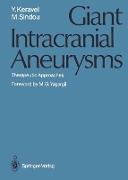Giant Intracranial Aneurysms
BücherAngebote / Angebote:
The first aneurysms explored by such pioneers of neurosurgery as Cushing and Dandy were the giant intracranial aneurysms. These giant aneurysms present many therapeutic difficulties and, because of their unique anatomical features and size, may present in a multitude of ways. With the advent of specialized imaging techniques such as computed tomography (CT), mag netic resonance imaging (MRI) and selective angiography, preoperative diag nosis today is most often accomplished without difficulty. However, com pletely thrombosed giant aneurysms may mimic other lesions with mass effect (such as basilar meningiomas, chordomas or chondromas) and their true anatomical shapes and relations to other cranial structures can only be ascer tained by direct operative inspection. Due to their morphological features (thrombosed, nonthrombosed, par tially thrombosed, fusiform), anatomical variations and difficult locations, giant aneurysms present new challenges for the modern neurosurgeon. Al though microsurgical techniques have rendered direct surgical treatment of giant intracranial aneurysms safer, elimination of the aneurysm without dis turbing the hemodynamics continues to be problematic. Some of these lesions have relatively small necks and can therefore be clipped fairly easily. Others have large necks, are fusiform, or contain perforators, how best to treat these lesions is a question still unresolved by presentday neurosurgery.
Folgt in ca. 5 Arbeitstagen




